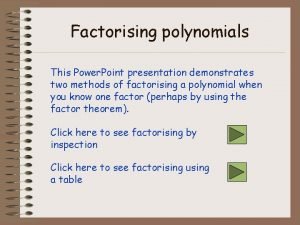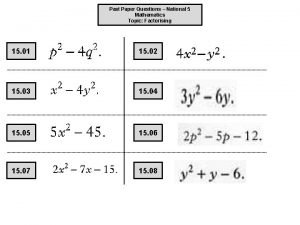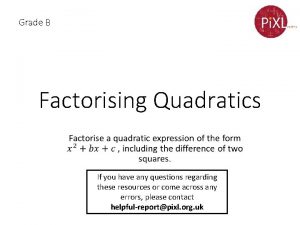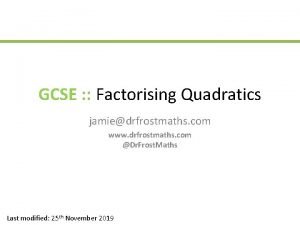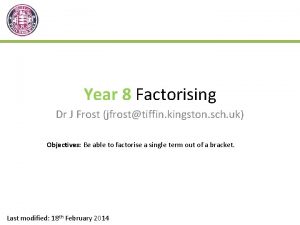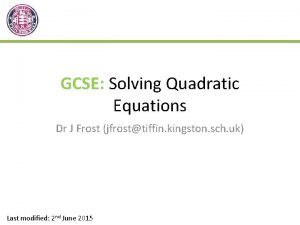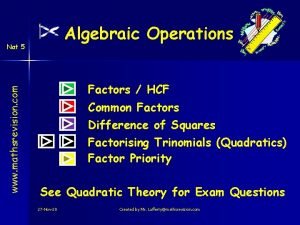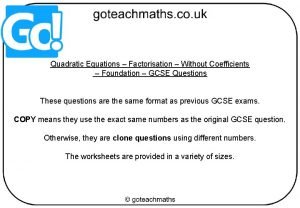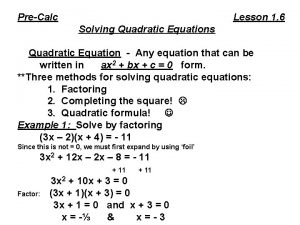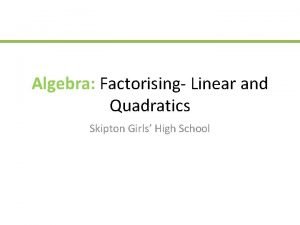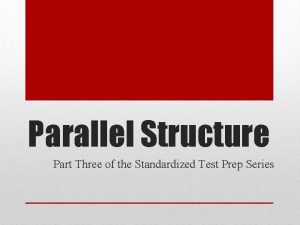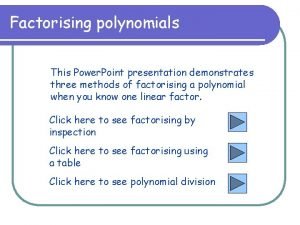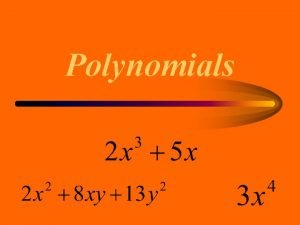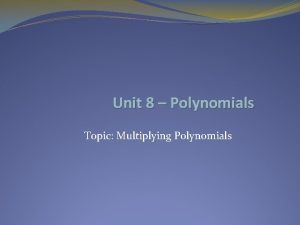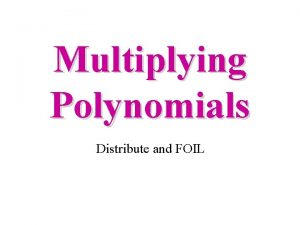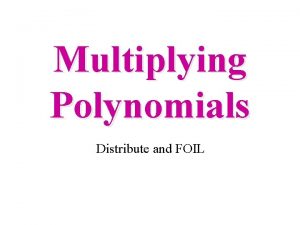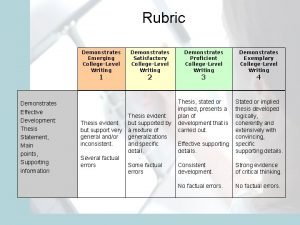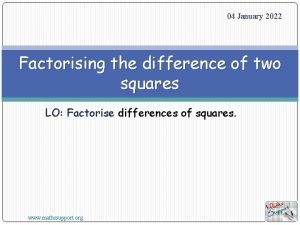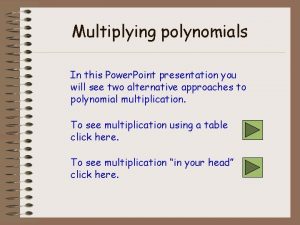Factorising polynomials This Power Point presentation demonstrates two



























- Slides: 27

Factorising polynomials This Power. Point presentation demonstrates two methods of factorising a polynomial when you know one factor (perhaps by using the factor theorem). Click here to see factorising by inspection Click here to see factorising using a table

Factorising by inspection If you divide 2 x³ - 5 x² - 4 x – 3 (cubic) by x – 3 (linear), then the result must be quadratic. Write the quadratic as ax² + bx + c. 2 x³ – 5 x² – 4 x + 3 = (x – 3)(ax² + bx + c)

Factorising by inspection Imagine multiplying out the brackets. The only way of getting a term in x³ is by multiplying x by ax², giving ax³. 2 x³ – 5 x² – 4 x + 3 = (x – 3)(ax² + bx + c) So a must be 2.

Factorising by inspection Imagine multiplying out the brackets. The only way of getting a term in x³ is by multiplying x by ax², giving ax³. 2 x³ – 5 x² – 4 x + 3 = (x – 3)(2 x² + bx + c) So a must be 2.

Factorising by inspection Now think about the constant term. You can only get a constant term by multiplying – 3 by c, giving – 3 c. 2 x³ – 5 x² – 4 x + 3 = (x – 3)(2 x² + bx + c) So c must be -1.

Factorising by inspection Now think about the constant term. You can only get a constant term by multiplying – 3 by c, giving – 3 c. 2 x³ – 5 x² – 4 x + 3 = (x – 3)(2 x² + bx - 1) So c must be -1.

Factorising by inspection Now think about the x² term. When you multiply out the brackets, you get two x² terms. -3 multiplied by 2 x² gives – 6 x² 2 x³ – 5 x² – 4 x + 3 = (x – 3)(2 x² + bx - 1) So – 6 x² + bx² = -5 x² therefore b must be 1. x multiplied by bx gives bx²

Factorising by inspection Now think about the x² term. When you multiply out the brackets, you get two x² terms. -3 multiplied by 2 x² gives – 6 x² 2 x³ – 5 x² – 4 x + 3 = (x – 3)(2 x² + 1 x - 1) So – 6 x² + bx² = -5 x² therefore b must be 1. x multiplied by bx gives bx²

Factorising by inspection You can check by looking at the x term. When you multiply out the brackets, you get two terms in x. -3 multiplied by x gives – 3 x 2 x³ – 5 x² – 4 x + 3 = (x – 3)(2 x² + x - 1) -3 x – x = -4 x as it should be! x multiplied by – 1 gives -x

Factorising by inspection Now factorise the quadratic in the usual way. 2 x³ – 5 x² – 4 x + 3 = (x – 3)(2 x² + x - 1) = (x – 3)(2 x – 1)(x + 1)

Factorising polynomials Click here to see this example of factorising by inspection again Click here to see factorising using a table Click here to end the presentation

Factorising using a table If you find factorising by inspection difficult, you may find this method easier. Some people like to multiply out brackets using a table, like this: x² 2 x 2 x³ 3 3 x² -3 x -4 -6 x² -9 x -8 x -12 So (2 x + 3)(x² - 3 x – 4) = 2 x³ - 3 x² - 17 x - 12 The method you are going to see now is basically the reverse of this process.

Factorising using a table If you divide 2 x³ - 5 x² - 4 x + 3 (cubic) by x – 3 (linear), then the result must be quadratic. Write the quadratic as ax² + bx + c. ax² x -3 bx c

Factorising using a table The result of multiplying out using this table has to be 2 x³ - 5 x² - 4 x + 3 x ax² 2 x³ bx c -3 The only x³ term appears here, so this must be 2 x³.

Factorising using a table The result of multiplying out using this table has to be 2 x³ - 5 x² - 4 x + 3 x ax² 2 x³ bx c -3 This means that a must be 2.

Factorising using a table The result of multiplying out using this table has to be 2 x³ - 5 x² - 4 x + 3 x 2 x² 2 x³ bx c -3 This means that a must be 2.

Factorising using a table The result of multiplying out using this table has to be 2 x³ - 5 x² - 4 x + 3 x -3 2 x² 2 x³ bx c 3 The constant term, 3, must appear here

Factorising using a table The result of multiplying out using this table has to be 2 x³ - 5 x² - 4 x + 3 x -3 2 x² 2 x³ bx c 3 so c must be – 1.

Factorising using a table The result of multiplying out using this table has to be 2 x³ - 5 x² - 4 x + 3 x -3 2 x² 2 x³ bx -1 3 so c must be – 1.

Factorising using a table The result of multiplying out using this table has to be 2 x³ - 5 x² - 4 x + 3 x 2 x² 2 x³ -3 -6 x² bx -1 -x 3 Two more spaces in the table can now be filled in

Factorising using a table The result of multiplying out using this table has to be 2 x³ - 5 x² - 4 x + 3 x 2 x² 2 x³ -3 -6 x² bx x² -1 -x 3 This space must contain an x² term and to make a total of – 5 x², this must be x²

Factorising using a table The result of multiplying out using this table has to be 2 x³ - 5 x² - 4 x + 3 x 2 x² 2 x³ -3 -6 x² bx x² -1 -x 3 This shows that b must be 1.

Factorising using a table The result of multiplying out using this table has to be 2 x³ - 5 x² - 4 x + 3 x 2 x² 2 x³ -3 -6 x² 1 x x² -1 -x 3 This shows that b must be 1.

Factorising using a table The result of multiplying out using this table has to be 2 x³ - 5 x² - 4 x + 3 2 x² 2 x³ x x² -1 -x -3 -6 x² -3 x 3 x Now the last space in the table can be filled in

Factorising using a table The result of multiplying out using this table has to be 2 x³ - 5 x² - 4 x + 3 2 x² 2 x³ x x² -1 -x -3 -6 x² -3 x 3 x and you can see that the term in x is – 4 x, as it should be. So 2 x³ - 5 x² - 4 x + 3 = (x – 3)(2 x² + x – 1)

Factorising by inspection Now factorise the quadratic in the usual way. 2 x³ – 5 x² – 4 x + 3 = (x – 3)(2 x² + x - 1) = (x – 3)(2 x – 1)(x + 1)

Factorising polynomials Click here to see this example of factorising using a table again Click here to see factorising by inspection Click here to end the presentation
 X³5x²
X³5x² Topics for powerpoint presentation for class 4
Topics for powerpoint presentation for class 4 Power point presentation design west vancouver
Power point presentation design west vancouver Power trianlge
Power trianlge Informsu
Informsu Point point power
Point point power One point perspective box
One point perspective box Past paper questions
Past paper questions Dr frost factorising quadratics
Dr frost factorising quadratics Dr frost maths
Dr frost maths Factorising single brackets worksheet
Factorising single brackets worksheet Dr frost factorising
Dr frost factorising Quadratic equations gcse
Quadratic equations gcse Mixed factorising worksheet
Mixed factorising worksheet Factorising nat 5
Factorising nat 5 T madas
T madas Expanding multiple brackets
Expanding multiple brackets Factorising questions gcse
Factorising questions gcse Factorising calc
Factorising calc Factorising calc
Factorising calc How to split middle term
How to split middle term Solve for x.
Solve for x. What is factorise
What is factorise Mr barton maths worksheets
Mr barton maths worksheets Which numbered section contains correct punctuation
Which numbered section contains correct punctuation Overregularization demonstrates a child's understanding of
Overregularization demonstrates a child's understanding of Mary likes hiking swimming and cycling
Mary likes hiking swimming and cycling Latent learning demonstrates that
Latent learning demonstrates that
